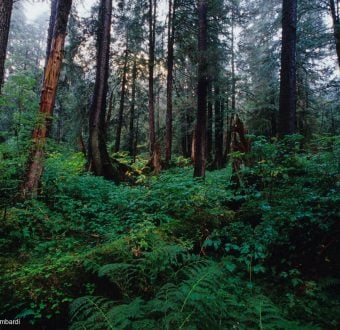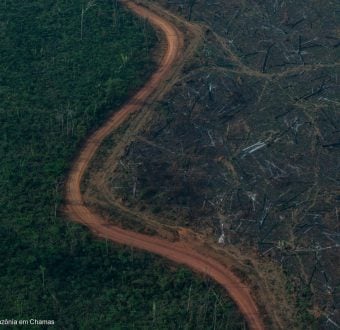Greenpeaceactivists completed the construction of a dam across one of the manycanals built to drain the rainforest and peat soils in order to makeway for plantations on the Kampar Peninsula on the Indonesian island ofSumatra.(2) This destruction emits huge quantities of CO2 and has ledIndonesia to become the world’s third largest climate polluter afterChina and the US.(3)
Greenpeace and members of the local forestcommunity have spent the last week constructing the dam and wereassisted over the weekend by Mélanie Laurent, star of QuentinTarantino’s new film Inglourious Basterds.
“Forestdestruction is one of the main causes of climate change. That is why Icame here to the frontline of forest destruction with Greenpeace, tocall on world leaders to end deforestation both here and around theglobe. It is key to preventing a climate catastrophe,” said MélanieLaurent, speaking from the rainforest.
Greenpeace has set up a‘Climate Defenders’ Camp’, in the heart of the Indonesian rainforestand intends to continue constructing dams across the Kampar Peninsula,which stores some 2 billion tonnes of carbon (4), in coming weeks asDecember’s UN climate summit approaches.
“We are takingaction to stop climate change right here at the frontline of forestdestruction. To pull the world back from the brink of a climate crisis,we need Obama, Merkel, Sarkozy, Brown and other world leaders to committo much deeper cuts in emissions from fossil fuels and to provide thecritical funds needed to end deforestation.(5) If they fail, we willface mass species extinction, floods, droughts and famine in ourlifetime,” said Greenpeace Southeast Asia campaigner Bustar Maitar.
Greenpeacewill release an Indonesian Forest Fund plan at the climate meeting inBarcelona at 18.00 CET. The plan shows how the fund could help rapidlyreduce emissions from deforestation.(6)
VVPR info: In Europe: Pat Venditti, Head of the forest campaign, Greenpeace International Matilda Bradshaw, Greenpeace International communications +31 In Indonesia: Bustar Maitar, Greenpeace Southeast Asia forest campaigner: +62 81344666135 Daniel Kessler, Greenpeace US media campaigner: +1 5107615455 Mélanie Laurent is available for interview on request. Please contact: +62 81 385 854 522 or Nabiha Shahab (Abby) on +62 81314213432 Photos, B roll and a video feature package are available from: Maarten van Rouveroy, Greenpeace International video producer, +31 (0) 646197322 John Novis, Greenpeace International photography, +44 (0) 7801 615 889
Notes: (1) Calculated from: IPCC (2007). IPCC Fourth Assessment Report, Working Group III, Final Chapter 1. Page 104. Figure 1.2: Sources of global CO2 emissions, 1970-2004 (only direct emissions by sector). http://www.ipcc.ch/ipccreports/ar4-wg3.htm (2) Most of the destruction of Indonesia’s rainforests and peatlands is caused by two main pulp and paper giants; Asia Pulp & Paper (APP – Sinar Mas) and its main rival, Asia Pacific Resources International Holding Limited (APRIL – RGE). Combined, these two companies control over 73% of Indonesia’s total pulp capacity, and control two of the world’s largest pulp mills. The ‘conversion’ of forested peatland is a three-stage process: • Usually, the most valuable trees are logged for timber. • A network of canals is built in order to remove logs and drain the peat so that it is suitable to grow plantations of oil palm for vegetable oil or acacia trees for pulp and paper. • The remaining forest is cleared, which causes the peat to dry out further and to release more CO2, (especially in El Niño years). (3) WRI 2008. Climate Analysis Indicators Tool (CAIT) Version 6.0 (Washington, DC: World Resources Institute) http://cait.wri.org <http://cait.wri.org/> (4) Greenpeace calculation based on Wahyunto, S. Ritung dan H. Subagjo (2003). Maps of Area of Peatland Distribution and Carbon Content in Sumatera, 1990 – 2002. Wetlands International – Indonesia Programme & Wildlife Habitat Canada (WHC). See also: Kampar Peninsula as a peat swamp forest conservation priority Briefing for NGO use only by Otto Miettinen, 21 July, 2007 http://www.maanystavat.fi/april/resourcesforkampar2007/Miettinen2007longKamparPeninsula.pdf (5) Greenpeace estimates that ending global deforestation requires industrialised countries to invest $42 billion (€30 billion) annually in forest protection. (6) For further information about the release of the fund proposal, please call Cindy Baxter, Greenpeace International communications at the Barcelona meeting +31 646197332. For further information please see: http://www.greenpeace.org/climatedefenders Background media briefing on Indonesia’s forests and climate change is available at: www.greenpeace.org/climatedefenders/rainforests-and-climate-change <http://www.greenpeace.org/climatedefenders/rainforests-and-climate-change>

